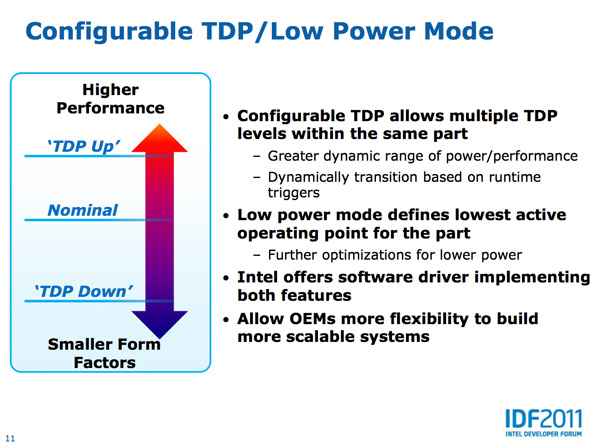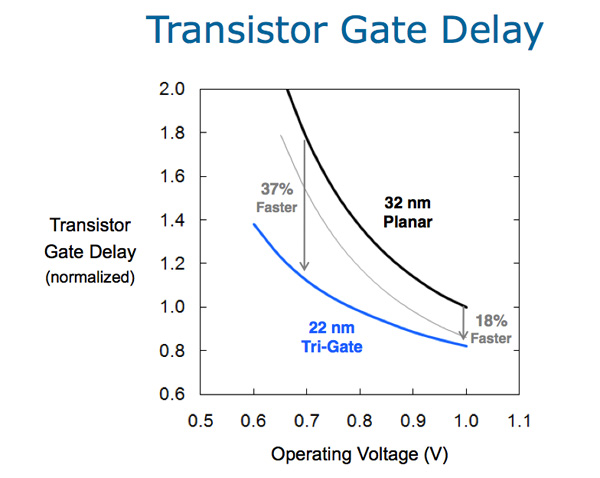Intel's Ivy Bridge Architecture Exposed
by Anand Lal Shimpi on September 17, 2011 2:00 AM EST- Posted in
- CPUs
- Intel
- Ivy Bridge
- IDF 2011
- Trade Shows
Power Efficiency Improvements
When Intel introduced its 22nm tri-gate transistors Intel claimed that it could see an 18% increase in performance at 1V compared to its 32nm process. At the same switching speed however, Intel's 22nm transistors can run at 75 - 80% of the voltage of their 32nm counterparts. Ivy Bridge's process alone should account for some pretty significant power savings. In addition to process however, there are a few architectural changes in IVB that will reduce power consumption.
Lower System Agent Voltages
Sandy Bridge introduced the System Agent, a name that used to refer to the uncore of a processor but now refers to the display output, memory controller, DMI and PCI Express interfaces. As of Sandy Bridge, the L3 cache was no longer included in the uncore and thus it wasn't a part of the System Agent.
The System Agent operates on a separate voltage plane than the rest of the chip. On Ivy Bridge Intel now offers even lower System Agent voltage options for the lower voltage SKUs, which in turn helps power optimize those SKUs.
More Accurate Voltage Characterization
Today Intel defines three different voltages for every Sandy Bridge CPU: LFM, nominal and turbo. LFM is the lowest frequency the CPU can run at (e.g. completely idle), nominal is the frequency it is specified to run at (e.g. 3.3GHz for a 2500K) and turbo is the highest available turbo frequency (e.g. 3.7GHz for a 2500K). Intel determines the lowest voltage possible for each one of those frequencies. Sandy Bridge obviously runs at more than just three frequencies, there are many more intermediate frequencies that it may run at depending on the current workload. The voltages at those intermediate frequencies are interpolated from the three points that I mentioned above.
With Ivy Bridge, Intel characterizes even more points along the frequency curve. Intel didn't reveal exactly how many points but it's more than three. A curve is then fit to the frequency/voltage data and depending on IVB's operating frequency a more accurate voltage point is calculated. The result from all of this seemingly simple work is a reduction in core voltage at these intermediate frequencies. Voltage changes have a cubic affect on power, so even a small reduction here can have a tangible impact. One of the points that wasn't previously characterized was max thread turbo. Ivy Bridge should be more power efficient in cases where you have all cores active.

Power Aware Interrupt Routing
This next feature is pretty neat. Ivy Bridge has logic to properly route interrupt requests to cores that are already awake vs. those that are asleep in their lowest power states. Obviously this approach can save a lot of power, however it may rob those active cores of some performance. IVB will allow prioritizing performance as well. Interrupt handling can thus be handled similarly to how it is today, or optimally for power savings.
Configurable TDP
I already wrote about what this is but if you missed our Pipeline post on it I'll briefly recap. All CPUs ship with a rated thermal design point (TDP) that tells OEMs what sort of cooling the chip requires. Traditionally that TDP value remained static and the CPU could do whatever it wanted but exceed that value. Ivy Bridge introduces configurable TDP that allows the platform to increase the CPU's TDP if given additional cooling, or decrease the TDP to fit into a smaller form factor.

The cTDP up mode is obviously for docked notebooks. You can imagine an Ivy Bridge notebook with an optional dock that could enhance the cooling capabilities of the machine. When undocked the notebook's processor would operate at a max TDP of 17W, for example, but toss it in a dock with additional cooling and the TDP would jump up to 33W. It's up to the OEMs to decide how they want to take advantage of this feature. It could be something as simple as a mobile dock with more fans, or something as complex as a modular water cooling solution with a bigger radiator in the dock. I haven't seen any concepts of systems that take advantage of Ivy Bridge's cTDP up support, but that's the theory.
What about cTDP down? Take the same 17W Ivy Bridge CPU from above but now drop the TDP to 13W, which in turn limits clock speed and voltage. Why would you want to do this? From the OEM perspective, Intel's TDP choices may seem arbitrary. Downwards configurable TDP allows OEMs to get a lower power configuration without forcing Intel to create a new SKU. OEMs can do this today through undervolting/underclocking of their own, but the cTDP down spec will at least give OEMs a guarantee of performance/power.
Configurable TDP obviously only applies to mobile Ivy Bridge. In particular the ultra low voltage and extreme edition parts will support cTDP. The cTDP values are listed in the table below:
| Ivy Bridge Configurable TDP | |||||
| cTDP Down | Nominal | cTDP Up | |||
| Ivy Bridge ULV | 13W | 17W | 33W | ||
| Ivy Bridge XE | 45W | 55W | 65W | ||
The most interesting are the 17W ULV Ivy Bridge parts as far as I'm concerned. Today you do sacrifice clock speed to get into the form factor of a MacBook Air. A clever OEM armed with Ivy Bridge might be able to deliver a cooling dock that would give you the best of both worlds: an ultra portable chassis on the go, and higher clock speeds while docked.











97 Comments
View All Comments
driscoll42 - Saturday, September 17, 2011 - link
On the last page there's "Should the fab engineers at Intel do their job well, Ivy Bridge could deliver much better power characteristics than Ivy." in the second paragraph, should that be Sandy on the end?Anand Lal Shimpi - Saturday, September 17, 2011 - link
Thank you! Fixed :)Take care,
Anand
Beenthere - Saturday, September 17, 2011 - link
It's good that Intel has decided that their GPU sucks and that to be competitive they need to catch up to AMD. This will take some time as AMD has a two year head start on APUs but it's all good for consumers.In spite of the marketing hype from Intel it looks like they've conceded that AMD has the better system approach with APUs for mainstream consumers and laptops. CPU performance alone is no longer a valid yardstick for PC performance thanks to AMD's advance thinking and Llano.
TypeS - Saturday, September 17, 2011 - link
I realize Intel is behind (has been for since anyone can remember) in the graphics arena compared to AMD/ATI and NVIDIA, but is AMD "two years ahead" in terms of an APU? While Clarkdale can't really be considered a true all in one package (hey remember when Kentsfield wasn't considered a true quad core?), it was still an all in one package, and with Sandy Bridge, Intel brought it all together onto one die. Intel isn't calling it an APU but if you compare SNB and Llano/Bulldozer, they share some similarities.AMD's edge is on graphics, and Intel is closing the gap.
I might be missing something though in why you say they are ahead in terms of an "APU", but from my knowledge, Intel as first to release a retail/commercial APU.
Guspaz - Monday, September 19, 2011 - link
Intel might be catching up in terms of physical performance, but Intel's drivers still, quite frankly, suck. It's the one thing really holding the platform back, in terms of both compatibility and performance. Even simple things like flash acceleration can sometimes be wonky with Intel's drivers.Furthermore, developers like Carmack have been pestering Intel to give them lower-level access to the hardware, with potentially enormous performance benefits; they'd like to treat PCs more like a console, and stripping away much of the driver/graphics overhead (particularly in terms of memory management) could see some pretty big performance gains. There's a reason why modern integrated GPUs like in Ivy Bridge have theoretical performance on-par with a 360 or PS3, but in practice, are nowhere near as performant.
Of course, the same is true for AMD and nVidia; high-end developers like Carmack and Sweeney seem to want lower-level access to hardware. From Carmack's latest QuakeCon keynote, it does seem like the hardware manufacturers are listening.
fic2 - Monday, September 19, 2011 - link
Yeah, Intel seems to want to catch up and made a pretty decent effort of no sucking with the HD3000. BUT then they go and do a dumb@ss thing like put the crappy HD2000 on 90% of the Sandies they sell. I think if marketing would get the he11 out of the way they wouldn't be too sucky.Oh, yeah, except the drivers.
bigboxes - Saturday, September 17, 2011 - link
I love AMD as much as the next guy (have three running AMD boxes), but are you going to continue to be "that guy" that posts this nonsense in every Intel/AMD thread? We get it. You love AMD and want to help them win the CPU wars. Yay for fanbois everywhere!Beenthere - Saturday, September 17, 2011 - link
Intel hasn't released an APU. They have released a CPU and GPU on the same slab of silicon. That's not an integrated APU.No nonsense, just facts. I like facts. Some folks can't handle facts but that's life. I like choice and scrupulous businesses. That's what AMD is unlike Intel.
ltcommanderdata - Saturday, September 17, 2011 - link
For someone arguing against marketing hype and looking for facts you seem overly preoccupied by AMD's APU term. If you are looking for which product currently on the market has tighter CPU/IGP integration then that produce is Sandy Bridge not Llano. For instance Sandy Bridge allows bidirectional communication/sharing of instructions and data between the CPUs and IGP via a shared on die L3 cache instead of through a crossbar and off die system memory as in Llano. Sandy Bridge also has more advanced power and thermal monitoring allowing efficient sharing of TDP room between the CPU and IGP, allowing each to be overclocked as needed, something Llano doesn't do.Yes, Llano has the faster GPU, but that's not the critical concern if what you are interested in is integration. Intel's CPU and GPU on a slab of silicon was Arrandale. Sandy Bridge has moved well beyond that. Llano's CPU/GPU integration looks to be somewhere in between Arrandale and Sandy Bridge. Seeing Llano is AMD's 1st generation Fusion product along with Brazos that's fine. But just because AMD's calls their product an APU doesn't mean it's the pinnacle of CPU/GPU integration.
gramboh - Sunday, September 18, 2011 - link
Boom. Beenthere just got roasted, and of course disappears rather than admitting he was wrong.